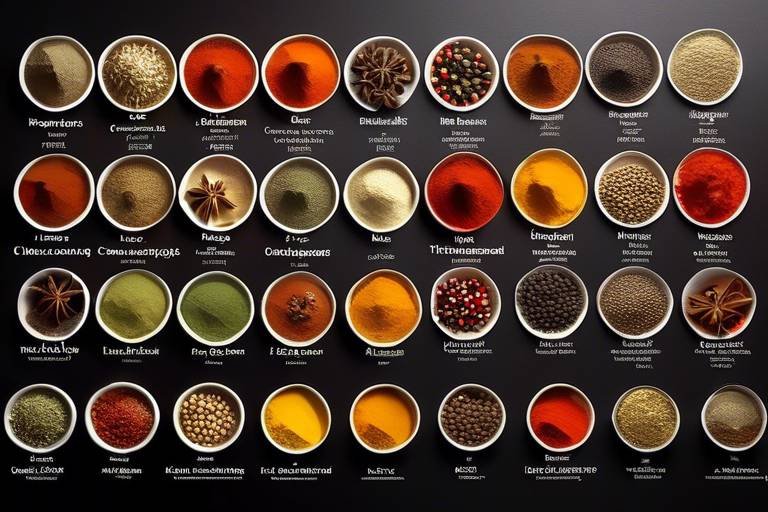The Biology of Skin Types - Caring for Your Unique Needs
Understanding your skin type is more than just a beauty trend; it's a journey into the biology of your largest organ. Your skin is not only a protective barrier but also a reflection of your overall health. It’s fascinating how each individual's skin can vary dramatically, influenced by a myriad of factors including genetics, environment, and lifestyle. By recognizing your unique skin type, you can tailor your skincare routine to meet its specific needs, ensuring your skin remains healthy and vibrant.
There are five primary skin types: normal, oily, dry, combination, and sensitive. Each type has its own set of characteristics. For instance, normal skin is often balanced, with a healthy glow and minimal imperfections. Oily skin, on the other hand, tends to produce excess sebum, leading to shine and potential breakouts. Dry skin feels tight and may flake, while combination skin exhibits traits of more than one type, often oily in the T-zone and dry on the cheeks. Sensitive skin can react easily to products and environmental factors, requiring extra care and attention.
When it comes to skincare, one size does not fit all. The first step in your skincare journey is identifying your skin type. This can be achieved through various methods, including observing how your skin reacts to different products and environmental changes. For example, does your skin feel oily after a long day or tight after washing? These observations can guide you in selecting the right products and routines tailored specifically for your skin's needs.
Moreover, it's essential to understand that our skin is not static; it evolves over time. Factors such as age, hormonal changes, and even stress can alter your skin type and its requirements. This means that what worked for you a few years ago may not necessarily be effective today. Therefore, remaining adaptable and attentive to your skin's signals is crucial for maintaining its health.
In the following sections, we will delve deeper into each skin type, exploring their unique characteristics and the specific care they require. We will also look at how external factors like climate and lifestyle can impact your skin, offering practical tips to help you navigate these challenges. So, whether you're dealing with a breakout or simply want to enhance your natural glow, understanding the biology of your skin is the first step toward achieving your skincare goals.
- How can I determine my skin type? You can determine your skin type by observing how your skin behaves after cleansing. If it feels tight, you might have dry skin; if it looks shiny, you may have oily skin.
- Can my skin type change over time? Yes, skin types can change due to factors like age, hormonal changes, and environmental influences.
- What is the best way to care for sensitive skin? For sensitive skin, choose gentle, fragrance-free products and always do a patch test before trying new products.

Understanding Skin Types
When it comes to skincare, understanding your unique skin type is like having the ultimate cheat sheet. Just like a fingerprint, everyone's skin is different, and it plays a crucial role in how we should care for it. Skin types are primarily categorized based on oil production, sensitivity, and environmental factors. The five main skin types include normal, oily, dry, combination, and sensitive. Each type has its own set of characteristics, and recognizing these can make a world of difference in your skincare routine.
Normal skin is often considered the holy grail; it’s neither too oily nor too dry, with a balanced moisture level and few imperfections. People with normal skin typically have a smooth texture, minimal visible pores, and a healthy glow. However, just because your skin is normal doesn’t mean you should neglect it—regular cleansing and moisturizing are still essential.
On the other hand, oily skin can feel like a slippery slope. Characterized by excess sebum production, this skin type often leads to shiny skin and enlarged pores. Oily skin is more prone to acne and blackheads, which can be frustrating. However, the silver lining is that oily skin tends to age more slowly due to its natural moisture content. To manage oily skin, look for products labeled as “oil-free” or “non-comedogenic.”
Then we have dry skin, which can sometimes feel like the Sahara Desert. People with dry skin often experience tightness, flakiness, and dullness. This skin type is usually caused by a lack of natural oils, which can be exacerbated by environmental factors like cold weather or hot showers. For dry skin, hydration is key! Look for rich creams and oils that can help lock in moisture.
Combination skin is a bit of a mixed bag, featuring both oily and dry areas. Typically, the T-zone (forehead, nose, and chin) may be oily, while the cheeks can be dry. This duality can make finding the right products a challenge, but it’s not impossible. It’s all about balance—using lighter products on oily areas and heavier creams on dry patches can work wonders.
Finally, sensitive skin is like that friend who gets easily overwhelmed. This type reacts quickly to various stimuli, leading to redness, itching, or burning sensations. Sensitive skin can be triggered by skincare products, environmental factors, or even stress. It’s crucial for individuals with sensitive skin to choose gentle, fragrance-free products to avoid irritation.
To summarize, here’s a quick table that captures the essence of each skin type:
| Skin Type | Characteristics | Care Tips |
|---|---|---|
| Normal | Balanced moisture, few imperfections | Regular cleansing and moisturizing |
| Oily | Shiny, enlarged pores, prone to acne | Use oil-free products |
| Dry | Tightness, flakiness, dullness | Hydrating creams and oils |
| Combination | Oily and dry areas | Balance products for each area |
| Sensitive | Reacts easily, redness, irritation | Gentle, fragrance-free products |
Understanding your skin type is the first step towards a tailored skincare routine that meets your unique needs. So, take a moment to assess your skin, and you'll be well on your way to achieving that radiant glow!

The Role of Genetics
When it comes to understanding our skin, one of the most significant factors at play is our genetics. Just like eye color or height, your skin type is largely determined by the genes you inherit from your parents. This means that if your mother had dry skin or your father had oily skin, there's a good chance you might experience similar traits. Isn’t it fascinating how our bodies carry the stories of generations before us?
Genetics not only dictate the type of skin you have but also influence various characteristics such as texture, elasticity, and the propensity for certain skin conditions. For instance, individuals with a family history of acne may be more prone to breakouts due to their skin's unique oil production patterns. Similarly, those with a genetic predisposition to conditions like eczema or psoriasis may find themselves facing these challenges more frequently.
Moreover, genetics play a crucial role in the aging process of our skin. Some people might age gracefully with minimal wrinkles, while others may notice fine lines and sagging at a younger age. This variability can be attributed to the collagen and elastin levels in our skin, which are influenced by our genetic makeup. In fact, studies have shown that about 60% to 80% of skin aging can be attributed to genetic factors!
It's important to note that while genetics lays the groundwork for your skin type and its characteristics, it doesn't mean you’re destined to suffer from skin issues. Understanding your genetic predispositions can empower you to make informed choices about your skincare routine. For example, if you know you have a tendency towards oily skin, you might opt for products that help control oil production and prevent breakouts.
To further illustrate the impact of genetics on skin types, consider the following table:
| Skin Type | Genetic Influence | Common Characteristics |
|---|---|---|
| Normal | Balanced oil production | Soft, smooth texture, few imperfections |
| Oily | Higher sebum production | Shiny appearance, prone to acne and enlarged pores |
| Dry | Lower oil production | Flaky, rough texture, may feel tight |
| Combination | Varied oil production in different areas | Oily in T-zone, dry or normal elsewhere |
| Sensitive | Genetic predisposition to irritation | Prone to redness, itching, or reactions |
Recognizing your skin's genetic background allows you to tailor your skincare approach. Just as you might choose a diet based on your health history, selecting skincare products that align with your genetic traits can lead to better results. So, the next time you’re shopping for skincare, remember to consider not just what’s trending, but what’s right for your unique skin.
- Can I change my skin type? While you can't change your genetic predisposition, you can manage your skin's condition through proper care and products tailored to your skin type.
- How can I find out my skin type? You can determine your skin type by observing how your skin reacts to different products and environmental conditions, or by consulting with a dermatologist.
- What if my skin type changes over time? It's normal for skin types to change due to factors like age, climate, and lifestyle. Regularly reassessing your skin can help you adjust your skincare routine accordingly.

Environmental Influences
When it comes to our skin, the environment plays a pivotal role in determining its health and appearance. Think of your skin as a living barrier, constantly interacting with the world around you. Factors such as climate, pollution, and sun exposure can significantly alter its condition, often leading to a range of issues from dryness to breakouts. For instance, if you live in a city with high levels of pollution, you may notice your skin feeling more congested and dull. On the flip side, those basking in sunny climates may struggle with increased oil production and sun damage. It's essential to adapt your skincare routine to these external influences to maintain optimal skin health.
Let's break down some of the key environmental factors:
- Climate: Different climates can affect your skin's moisture levels. For example, in humid areas, your skin might produce excess oil, while in dry climates, it can become parched and flaky.
- Pollution: Airborne toxins can lead to premature aging and skin irritation. Regular cleansing is vital to remove impurities that settle on your skin.
- Sun Exposure: UV rays can cause sunburn, age spots, and increase the risk of skin cancer. Sunscreen isn't just a summer essential; it's a year-round necessity.
Adapting your skincare routine to account for these factors can be as simple as switching products or changing your daily habits. For instance, if you live in a polluted urban area, consider incorporating a gentle exfoliant into your routine to help remove dead skin cells and impurities that accumulate from the environment. On the other hand, if you're in a dry climate, opt for richer moisturizers that can provide your skin with the hydration it craves.
Moreover, seasonal changes can also impact skin health. During the winter months, the cold air can strip moisture from your skin, leading to dryness and irritation. In contrast, summer heat can cause excessive sweating and oiliness. Adjusting your skincare products seasonally can make a significant difference. For example, in winter, you might want to switch to a heavier cream, while in summer, a lightweight gel moisturizer could be more appropriate.
In conclusion, understanding how environmental influences affect your skin is crucial for developing a personalized skincare regimen. By being aware of these factors and making the necessary adjustments, you can help your skin thrive no matter where you are or what the weather is like.
Q: How can I protect my skin from pollution?
A: Regular cleansing with a gentle cleanser can help remove pollutants. Additionally, using antioxidants in your skincare can provide a protective barrier against environmental damage.
Q: Should I change my skincare routine with the seasons?
A: Absolutely! Your skin's needs can change with the seasons, so it's wise to adjust your products accordingly to maintain optimal hydration and protection.
Q: What are the best ingredients for oily skin in polluted areas?
A: Look for ingredients like salicylic acid, which can help control oil production, and antioxidants such as vitamin C to combat the effects of pollution.

Seasonal Changes
As the seasons change, so do our skin's needs. It's like your skin is a chameleon, adapting to the environment around it. In the winter, for instance, the cold, dry air can strip moisture from your skin, leaving it feeling parched and tight. On the other hand, summer brings heat and humidity, which can lead to excess oil production and breakouts. Understanding how these seasonal shifts affect your skin is essential for maintaining its health and vitality.
In winter, the lack of humidity can cause your skin to become dry and flaky. This is the time to switch to richer, more hydrating creams and serums. Look for ingredients like hyaluronic acid and glycerin, which can help lock in moisture. Additionally, using a humidifier in your home can create a more skin-friendly environment, preventing that dreaded winter dryness.
Conversely, during the summer months, the heat can make your skin produce more oil, leading to clogged pores and breakouts. To combat this, you might want to opt for lighter, oil-free products that won't weigh your skin down. Ingredients such as salicylic acid can help keep your pores clear and reduce the likelihood of acne. Don't forget the sunscreen! Protecting your skin from harmful UV rays is crucial, no matter the season.
It's also worth noting that seasonal changes can affect not just the texture and oiliness of your skin, but also its overall tone and sensitivity. For example, spring can bring about allergies that may result in redness or irritation. During this time, it’s advisable to use calming products with ingredients like aloe vera or chamomile to soothe your skin.
To help you navigate your skincare routine through the seasons, here’s a quick comparison:
| Season | Skin Needs | Recommended Products |
|---|---|---|
| Winter | Hydration, nourishment | Rich creams, serums with hyaluronic acid |
| Spring | Calm, soothe | Gentle cleansers, aloe vera-based products |
| Summer | Oil control, sun protection | Oil-free moisturizers, sunscreen with SPF 30+ |
| Fall | Repair, replenish | Exfoliators, nourishing oils |
In summary, adjusting your skincare routine according to seasonal changes is not just beneficial; it's essential. By paying attention to how your skin reacts to different weather conditions and making the necessary adjustments, you can keep it looking vibrant and healthy all year round. So, the next time the seasons shift, remember to give your skin the love and care it deserves!
- How often should I change my skincare routine with the seasons? It's best to reassess your routine at the start of each season, making changes based on your skin's needs.
- Can I use the same products year-round? While some products may work well year-round, many will require seasonal adjustments to cater to changing skin conditions.
- What ingredients should I look for in winter skincare? Look for hydrating ingredients like hyaluronic acid, glycerin, and ceramides to combat dryness.
- How can I protect my skin in summer? Use oil-free products, exfoliate regularly, and always apply sunscreen to protect against UV damage.

Urban vs. Rural Living
When it comes to skin health, your living environment can play a significant role in how your skin behaves and reacts. Urban living often exposes individuals to higher levels of pollution, stress, and artificial environments, which can lead to various skin issues. Think about it: the hustle and bustle of city life, with its smoggy air and constant exposure to UV rays, can wreak havoc on your skin. For instance, pollution particles can penetrate the skin's barrier, leading to premature aging, breakouts, and a dull complexion.
On the flip side, rural living typically offers cleaner air and a more natural environment, which can be beneficial for your skin. However, it’s not without its challenges. Rural areas may have limited access to skincare products and dermatological services, and exposure to the elements—like sun and wind—can lead to dryness and irritation. It’s a classic case of the grass being greener on the other side, but both environments have their unique skincare needs.
To help you navigate the differences, here’s a quick comparison of how urban and rural living can affect your skin:
| Aspect | Urban Living | Rural Living |
|---|---|---|
| Pollution Levels | High, leading to clogged pores and skin irritation | Low, generally better for skin health |
| Sun Exposure | Often increased due to reflective surfaces and less shade | Natural exposure, but may require more sun protection |
| Access to Products | Wide variety available | Limited options, may require online shopping |
| Stress Levels | Higher due to fast-paced lifestyle | Generally lower, but can vary |
So, how can you adapt your skincare routine based on your living environment? If you're in an urban setting, consider incorporating products with antioxidants to combat pollution and protect your skin. Look for cleansers that can effectively remove impurities without stripping your skin of its natural oils. On the other hand, if you live in a rural area, focus on hydration and protection from the elements. A good moisturizer and sunscreen are essential to shield your skin from wind and sun damage.
Ultimately, whether you're navigating the concrete jungle or enjoying the fresh air of the countryside, understanding how your environment affects your skin can empower you to make informed choices. Tailoring your skincare routine to your unique circumstances is key to maintaining healthy, glowing skin.
- How does pollution affect my skin? Pollution can lead to clogged pores, premature aging, and skin irritation.
- What are the best products for urban skin? Look for antioxidants, gentle cleansers, and hydrating moisturizers.
- How can I protect my skin in rural areas? Focus on hydration and use sunscreen to protect against sun and wind exposure.
- Should I change my skincare routine based on the season? Yes, adjusting your routine to accommodate seasonal changes can help maintain skin health.

Identifying Your Skin Type
Identifying your skin type is a vital step in crafting the perfect skincare routine. Think of it as finding the right pair of shoes; if they don’t fit well, you’ll be uncomfortable no matter how stylish they are! Knowing whether your skin is normal, oily, dry, combination, or sensitive can help you choose products that truly work for you. So, how can you pinpoint your skin type? Let’s dive in!
One of the simplest methods to determine your skin type is the bare-faced test. This involves cleansing your face gently with a mild cleanser and then leaving it free from any products for about an hour. After this period, observe how your skin feels:
- If your skin feels tight and looks flaky, you likely have dry skin.
- If your skin appears shiny and feels greasy, you probably have oily skin.
- If your T-zone (forehead, nose, and chin) is oily but your cheeks are dry, you have combination skin.
- If your skin feels comfortable and balanced, congratulations! You have normal skin.
- If your skin reacts easily to products or environmental factors, you may have sensitive skin.
Another method involves observing how your skin behaves throughout the day. For instance, does it get oily by midday? Or does it feel parched after a few hours? These daily changes can provide insight into your skin’s needs. Additionally, factors like age, diet, and lifestyle can all influence your skin type. For example, hormonal changes during puberty or pregnancy can lead to shifts in oil production, making it essential to reassess your skin type periodically.
Moreover, understanding your skin's reactivity is crucial. If you notice redness, itching, or breakouts after using certain products, your skin may be sensitive. In such cases, opting for gentle, fragrance-free products can help minimize irritation. If you’re unsure, consider consulting a dermatologist. They can perform tests and provide tailored recommendations to help you understand your skin better.
Lastly, keep in mind that your skin type can change due to various factors, including seasonal changes and environmental influences. For instance, you might find your skin becoming drier in winter due to low humidity or oilier in summer because of increased sweat and heat. Therefore, regularly reassessing your skin type is essential for maintaining its health and vibrancy.
Q: Can my skin type change over time?
A: Yes, factors such as age, hormonal changes, and environmental conditions can cause your skin type to change. It’s important to reassess your skin regularly.
Q: How often should I check my skin type?
A: It’s advisable to check your skin type every few months or whenever you notice significant changes in your skin’s condition.
Q: Are there specific products for each skin type?
A: Absolutely! Each skin type has unique needs, and using the right products can help address those specific concerns effectively.
Q: What should I do if I have combination skin?
A: For combination skin, consider using products that balance oil and hydration. Look for lightweight moisturizers and non-comedogenic formulas that won’t clog your pores.

Skincare Routines for Each Type
When it comes to skincare, one size definitely does not fit all. Each skin type has its own unique needs, and understanding those needs is the first step toward achieving healthy, radiant skin. Whether your skin is normal, oily, dry, combination, or sensitive, having a tailored skincare routine can make all the difference. Let's dive into the specifics of each skin type and explore how to nurture your skin effectively.
Starting with normal skin, this type is often characterized by a balanced oil and moisture level, making it relatively low-maintenance. A simple routine that includes a gentle cleanser, a lightweight moisturizer, and sunscreen will keep it looking fresh. However, don’t forget to exfoliate once or twice a week to remove dead skin cells and maintain that healthy glow.
For those with oily skin, the key is to find products that can help control excess oil without stripping the skin of its natural moisture. Look for a foaming cleanser that contains salicylic acid or tea tree oil to help reduce shine. Follow up with an oil-free moisturizer and a mattifying sunscreen. Incorporating a clay mask into your routine once a week can also help to absorb excess oil and prevent breakouts.
Dry skin, on the other hand, craves hydration. If your skin feels tight or flaky, you need a routine that focuses on moisture retention. Start with a creamy, hydrating cleanser, followed by a rich moisturizer that contains ingredients like hyaluronic acid or glycerin. Don’t skip sunscreen, as UV rays can further dehydrate your skin. A nourishing overnight mask can work wonders while you sleep, providing that extra boost of hydration.
Combination skin can feel like a puzzle, with different areas of the face requiring different care. Typically, the T-zone (forehead, nose, and chin) may be oily, while the cheeks are dry. To manage this, use a gentle cleanser suitable for all skin types, and apply a lightweight moisturizer on the T-zone while using a richer cream on the drier areas. Exfoliate regularly but be cautious not to overdo it, as this can lead to irritation.
Finally, for those with sensitive skin, the focus should be on soothing and calming the skin. Use fragrance-free and hypoallergenic products to minimize irritation. A mild cleanser followed by a gentle, hydrating moisturizer is essential. Incorporating ingredients like aloe vera or chamomile can help soothe redness and inflammation. Always patch-test new products to ensure they won’t trigger a reaction.
Here’s a quick overview of skincare routines for each skin type:
| Skin Type | Recommended Routine |
|---|---|
| Normal | Gentle cleanser, lightweight moisturizer, sunscreen, exfoliate weekly |
| Oily | Foaming cleanser with salicylic acid, oil-free moisturizer, mattifying sunscreen, clay mask weekly |
| Dry | Creamy hydrating cleanser, rich moisturizer with hyaluronic acid, sunscreen, overnight mask |
| Combination | Gentle cleanser, lightweight moisturizer for T-zone, richer cream for dry areas, regular exfoliation |
| Sensitive | Fragrance-free cleanser, hypoallergenic moisturizer, soothing ingredients, patch-test new products |
In conclusion, developing a skincare routine tailored to your specific skin type is essential for promoting healthy skin. Remember that what works for one person may not work for another, so take the time to experiment and find what makes your skin feel its best. And don’t forget, consistency is key! Stick to your routine, and you’ll be well on your way to achieving that glowing complexion you desire.
Q: How often should I change my skincare routine?
A: It's best to reassess your routine every few months or whenever you notice significant changes in your skin's condition. Seasonal changes, hormonal shifts, and lifestyle changes can all necessitate adjustments.
Q: Can I use the same products for different skin types?
A: While some products can be suitable for multiple skin types, it's generally more effective to use products specifically formulated for your skin type to address its unique needs.
Q: How can I tell if a product is right for my skin type?
A: Always read the ingredient list and look for products labeled for your specific skin type. Additionally, conducting a patch test can help determine if a product will work for you without causing irritation.

Common Skincare Ingredients
When it comes to skincare, understanding the ingredients in your products is like knowing the secret recipe to your favorite dish. Just as you wouldn’t want to eat something that doesn’t agree with your taste buds, you also want to ensure that the ingredients on your skin are beneficial. Different skin types react differently to various ingredients, making it crucial to choose products that cater to your unique needs.
Let’s break it down:
- Normal Skin: For those with normal skin, ingredients like hyaluronic acid and glycerin are fantastic for maintaining moisture without overwhelming the skin. These ingredients ensure hydration while keeping the skin balanced and healthy.
- Oily Skin: If you have oily skin, look for products containing salicylic acid or niacinamide. Salicylic acid helps to exfoliate and unclog pores, while niacinamide can reduce oil production and minimize the appearance of pores.
- Dry Skin: For dry skin types, ingredients such as ceramides and sheabutter are your best friends. They work to restore the skin's barrier, locking in moisture and providing much-needed hydration to combat dryness.
- Combination Skin: Those with combination skin should look for a balance of ingredients like aloe vera and vitamin E. Aloe vera hydrates without being greasy, while vitamin E provides antioxidant protection.
- Sensitive Skin: If you have sensitive skin, opt for products with calendula or chamomile. These ingredients are known for their soothing properties, helping to calm irritation and redness.
Now, let’s not forget the importance of avoiding certain ingredients that can wreak havoc on your skin. For example, alcohols can be drying, while fragrances can lead to irritation, especially for sensitive skin types. Always read product labels and be cautious of what you apply to your skin.
Additionally, it’s essential to consider the formulation of these ingredients. A product might boast about having a fantastic ingredient, but if it’s not in a stable or effective formulation, it won’t do you any good. For instance, certain vitamins, like vitamin C, are highly effective but can degrade quickly if not packaged properly. Look for serums in dark glass bottles to protect them from light exposure.
In the end, knowing what works for your skin is a journey of trial and error, but having a solid understanding of common skincare ingredients can guide you along the way. Remember, just because a product is popular doesn’t mean it’s right for you. Always prioritize your skin’s unique needs, and don’t hesitate to consult with a dermatologist for tailored advice.
Q: How do I know which ingredients are right for my skin type?
A: Start by identifying your skin type and then research ingredients that are known to benefit that type. Consulting with a dermatologist can also provide personalized recommendations.
Q: Are natural ingredients always better for my skin?
A: Not necessarily. While natural ingredients can be beneficial, they can also cause reactions in some individuals. It’s essential to patch test any new product, regardless of its origin.
Q: How can I tell if a product is effective?
A: Look for products with proven ingredients and stable formulations. Additionally, give your skin time to adjust to new products, as it may take several weeks to see noticeable results.

Professional Treatments
When it comes to skincare, sometimes our at-home routines just don't cut it. If you've been struggling with persistent skin issues, professional treatments might be the game changer you need. These treatments are designed to address specific skin concerns more effectively than over-the-counter products. From acne scars to fine lines, there are a variety of options available that can help rejuvenate your skin and boost your confidence.
One of the most popular professional treatments is chemical peels. These involve applying a solution to the skin that causes it to exfoliate and eventually peel off, revealing fresher, smoother skin underneath. Depending on your skin type and concerns, there are different strengths of chemical peels available, ranging from light peels that require minimal downtime to deeper peels that can take weeks to heal. It's like shedding an old layer of skin to reveal the new and improved you!
Microdermabrasion is another effective treatment that can help with uneven skin tone, texture, and fine lines. This procedure uses tiny crystals to gently exfoliate the skin, removing dead skin cells and promoting new cell growth. Many people liken it to a mini-facial that leaves your skin feeling rejuvenated and glowing. Plus, it's non-invasive and typically requires no downtime, making it a great option for those with busy schedules.
If you're dealing with more serious concerns like acne or rosacea, laser treatments might be the solution. These treatments use focused light energy to target specific skin issues, such as reducing redness or eliminating acne-causing bacteria. There are various types of lasers available, each tailored to different skin types and conditions. It's essential to consult with a dermatologist to determine which laser treatment is best for your unique needs.
For those looking to combat signs of aging, dermal fillers and Botox are popular choices. Dermal fillers add volume to areas like the cheeks and lips, while Botox works by temporarily relaxing the muscles that cause wrinkles. These treatments can take years off your appearance and are often referred to as a “lunch break” procedure due to their quick application and minimal recovery time.
Before deciding on any professional treatment, it's crucial to have a thorough consultation with a qualified dermatologist. They can assess your skin type, discuss your concerns, and recommend the best course of action tailored specifically to you. Remember, what works wonders for one person might not be suitable for another, so personalized care is key.
In summary, professional treatments can significantly enhance your skincare routine and address concerns that might be too stubborn for at-home solutions. Whether you're considering a chemical peel, microdermabrasion, laser treatment, or injectables, the right professional care can help you achieve the glowing skin you desire.
- How often should I get professional treatments? It varies based on the treatment and your skin type. Consult with your dermatologist for a personalized schedule.
- Are professional treatments safe? Yes, when performed by a qualified professional, these treatments are generally safe. Always discuss any concerns with your provider.
- Will I need downtime after treatments? Some treatments may require downtime, while others have little to no recovery time. It’s best to ask your provider about what to expect.
- How do I choose the right treatment for my skin type? A consultation with a dermatologist is essential to determine the most suitable treatment for your specific skin needs.
Frequently Asked Questions
-
What are the different skin types?
Skin types can be categorized into five primary groups: normal, oily, dry, combination, and sensitive. Each type has distinct characteristics, such as oil production and sensitivity levels, which affect how you should care for your skin.
-
How do I determine my skin type?
Identifying your skin type can be done through a simple test. Start by cleansing your face and leaving it bare for about an hour. Observe how your skin feels: if it’s tight and flaky, you likely have dry skin; if it’s shiny, you may have oily skin; and if there are dry patches alongside oiliness, you probably have a combination skin type.
-
How can genetics affect my skin type?
Your genetics play a significant role in determining your skin type and its characteristics. Factors like oil production, skin texture, and even how quickly your skin ages can all be inherited from your parents. Understanding this can help you tailor your skincare routine for better results.
-
What environmental factors should I consider for my skin?
Environmental influences such as climate, pollution, and sun exposure can significantly impact your skin's health. Adapting your skincare routine to these factors is essential. For instance, using heavier moisturizers in winter or applying sunscreen in sunny conditions can help maintain your skin's balance.
-
How do seasonal changes affect my skincare routine?
Seasons can greatly influence your skin's needs. In summer, you may need lighter products to combat oiliness, while in winter, your skin might require more hydration. Adjusting your skincare routine seasonally ensures that your skin remains healthy and well-cared for throughout the year.
-
What are some common skincare ingredients that work for specific skin types?
Understanding which ingredients benefit your skin type is crucial. For example, salicylic acid is great for oily skin, while hyaluronic acid is perfect for dry skin. Always check product labels to ensure you're using ingredients that align with your skin's unique needs.
-
Are professional treatments necessary for skincare?
While many people can achieve healthy skin through a good home routine, professional treatments can address specific concerns more effectively. Options like chemical peels, microdermabrasion, and laser therapy can enhance your skincare results and are worth considering if you have persistent issues.



















